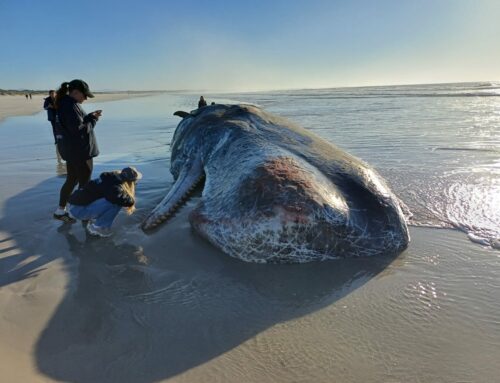The National Environmental Management: Biodiversity Act (NEMBA) has clear regulations to protect marine species, particularly whales. According to the Threatened or Protected Marine Species (TOPS) regulations, all vessels (motorised or unmotorised) as well as drones, microlights, helicopters, and airplanes must maintain a minimum distance of 300 meters from the animal. This restriction applies both at sea and in the air, ensuring that marine life remains undisturbed by human activity.
There are limited exceptions to this rule, individuals or organizations that have obtained a valid filming or research permit are allowed to approach the animals closer than 300m. Additionally, anyone using Unmanned Aerial Vehicles (UAVs – drones) for commercial purposes is required to hold a license from the South African Civil Aviation Authority (SACAA) to legally operate Remotely Piloted Aircraft Systems (RPAS).
UAVs in Marine Wildlife Research
The use of UAVs for wildlife research and monitoring has grown significantly. These tools provide valuable aerial perspectives for studying marine mammals without the need for intrusive human presence. Research suggests that the underwater noise generated by small- and medium-sized UAVs is often below ambient noise levels, meaning it is unlikely to significantly impact cetaceans.
Not all UAVs generate the same level of noise. A study by Laute et al. (2023) has compared various drone models, revealing notable differences:
- Mavic: The quietest UAV, producing minimal ambient noise disruption.
- Phantom: Moderately loud.
- Inspire: The loudest among the tested models, with higher noise emissions detected at close range.
Despite these variations, even the loudest UAVs remain well below the noise levels required to cause direct auditory damage to marine mammals. Factors such as an animal’s hearing range, sensitivity, and ambient noise conditions play a role in determining whether UAV-generated sounds are even perceived.
A study by Christiansen et al. (2016) found that UAVs produced minimal underwater noise, and similar findings were reported in another study that was published in 2017. These studies indicate that most of the sound generated by drones is reflected off the water surface, leading to minimal sound transmission underwater. Behavioural studies on southern right whales have provided insight into how these marine mammals respond to the UAVs presence. Research shows that mother-calf pairs on breeding grounds, typically found close to shore in or near the surf zone, do not exhibit noticeable behavioural changes when UAVs fly overhead. This suggests that the whales are either unaware of the UAVs or are not disturbed by them due to the high ambient noise levels in the nearshore waters. Laute et al. (2023) showed the sound by a small boat passing at 1.38 km distance to the hydrophone was significantly louder than the median received level of the loudest of the three UAVs tested. Additionally, UAV noise emissions at an altitude of 5 meters remained below the threshold for non-impulsive physical injury and behavioural disturbance as set by the National Marine Fisheries Service in Australia.
Final Thoughts
The strict regulations outlined in NEMBA’s serve as a crucial role in protecting marine life, ensuring human activities—including research and tourism—do not disrupt the natural behaviour of whales and other threatened marine species. UAVs present an innovative tool for marine research, and current studies indicate that their impact on whales is minimal when used responsibly.
For those interested in operating drones in marine environments, it is essential to adhere to the legal requirements and ethical guidelines to promote responsible wildlife monitoring and conservation efforts.
Reference and further readings
Christiansen, Fredrik, et al. “Southern right whales show no behavioral response to low noise levels from a nearby unmanned aerial vehicle.” Marine Mammal Science 36.3 (2020): 953-963.
Christiansen, Fredrik, et al. “Noise levels of multi-rotor unmanned aerial vehicles with implications for potential underwater impacts on marine mammals.” Frontiers in Marine Science 3 (2016): 277.
Erbe, Christine, et al. “Aerial and underwater sound of unmanned aerial vehicles (UAV).” Journal of Unmanned Vehicle Systems 5.3 (2017): 92-101.
Laute, Amelie, et al. “Underwater sound of three unoccupied aerial vehicles at varying altitudes and horizontal distances.” The Journal of the Acoustical Society of America 153.6 (2023): 3419-3419.
Department of Environmental Affairs – National Environmental Management : Biodiversity Act, 2004
https://www.gov.za/sites/default/files/gcis_document/201409/36375gen388.pdf





